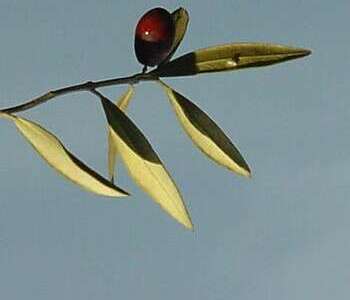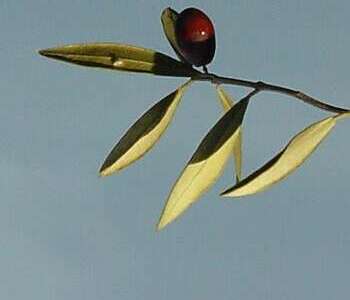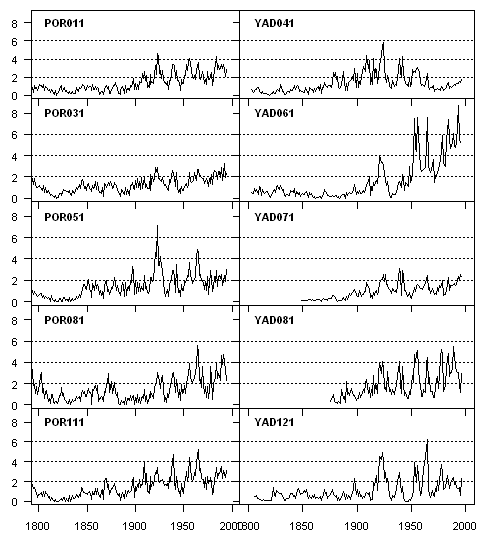


01 October 2009 Blog Home : October 2009 : Permalink
Blog Home : October 2009 : Permalink
My attention has been drawn to a comment by Steve McIntyre on the Climate Audit website relating to the pattern of radial tree growth displayed in the ring-width chronology "Yamal" that I first published in Briffa (2000). The substantive implication of McIntyre's comment (made explicitly in subsequent postings by others) is that the recent data that make up this chronology (i.e. the ring-width measurements from living trees) were purposely selected by me from among a larger available data set, specifically because they exhibited recent growth increases.
Paragraph 1's claim is that people such as I believe Briffa worked back from the answer to derive the question. The reason why we think that is that other studies of trees in the vicinity have different results but yet the result that seems most widely cited is the one that is most closely allied with the idea that recent global temperatures are unprecedentedly hot. The problem here is that Brifa's actions - modifying the divergent Taymir but not the Yamal and so on - seem to suggest that not all chronologies are treated equally and that the ones that get modified are the ones that fail to meet the narrative.This is not the case. The Yamal tree-ring chronology (see also Briffa and Osborn 2002, Briffa et al. 2008) was based on the application of a tree-ring processing method applied to the same set of composite sub-fossil and living-tree ring-width measurements provided to me by Rashit Hantemirov and Stepan Shiyatov which forms the basis of a chronology they published (Hantemirov and Shiyatov 2002). In their work they traditionally applied a data processing method (corridor standardisation) that does not preserve evidence of long timescale growth changes. My application of the Regional Curve Standardisation method to these same data was intended to better represent the multi-decadal to centennial growth variations necessary to infer the longer-term variability in average summer temperatures in the Yamal region: to provide a direct comparison with the chronology produced by Hantemirov and Shiyatov.
This is probably the key paragraph, and the one where Briffa is most guilty of "supressio veri" and "suggestion falsi". The implication one gets from paragraph 2 is that Briffa uses the same data as H&S and that all he is doing is running a different processing method on the same raw data. As it happens it is relatively trivial to show that Briffa is using rather more cores than H&S do for their chronologies - that is to say that H&S discard data that Briffa uses. All you do is take the H&S data and import it into a spreadsheet, noting that the final column is the count of cores for the year (column 1). Then you run a perl script* on Briffa's data to extract the count of cores for each year and output that in "year count" format. This is then imported into the spreadsheet on a different worksheet. Then you take the H&S core count for the same years as Briffa (-202 - 1996) and paste it into column 3 od the briffa page. Finally you chart the three colunms and get


These authors state that their data (derived mainly from measurements of relic wood dating back over more than 2,000 years) included 17 ring-width series derived from living trees that were between 200-400 years old. These recent data included measurements from at least 3 different locations in the Yamal region. In his piece, McIntyre replaces a number (12) of these original measurement series with more data (34 series) from a single location (not one of the above) within the Yamal region, at which the trees apparently do not show the same overall growth increase registered in our data.
Oddly the more recent years are dropped for many of the 17 living trees. If the trees were still living one might expect the count of 17 to remain as the modern minimum. It doesn't. The reason why Steve M adds/replaces an additional 34 trees from nearby is that the core count drops so much at the end. It therefore seems reasonable that, as Briffa himself did with his Taymir/Avam-Taymir study, someone should add some additional trees at the end. At least these trees are smack bang in the long/lat zone of the original H&S Study and not 300 km away as Avam is from Taymir. One might add that we have no idea how distant the Schweingruber 34 are from any of the H&S sample sites.The basis for McIntyre's selection of which of our (i.e. Hantemirov and Shiyatov's) data to exclude and which to use in replacement is not clear but his version of the chronology shows lower relative growth in recent decades than is displayed in my original chronology. He offers no justification for excluding the original data; and in one version of the chronology where he retains them, he appears to give them inappropriate low weights. I note that McIntyre qualifies the presentation of his version(s) of the chronology by reference to a number of valid points that require further investigation. Subsequent postings appear to pay no heed to these caveats. Whether the McIntyre version is any more robust a representation of regional tree growth in Yamal than my original, remains to be established.
This is very rather cheeky. Steve replaced the 12 surviving trees with data in the 1980s because these trees seem to show dramatic growth in the 20th century with 34 other trees from nearby in order to see whether the 20th centruy growth spurt was common to other trees in that area. His result pretty clearly showed that it wasn't and indeed subsequent number crunching seems to indcate that most of this growth spurt is due to a single core (YAD061). I should note that the low weighting comment appears to be bunk - as Briffa could verify by running the code Steve has made available - unless I've misunderstood things all Steve does is add 34 trees with each tree given equal weight. As for robustness, it is worth pointing out that the Esper Polar Urals, the H&S Yamal and a paper by Gurskaya of nearby Ust Voykar all show similar results for 20th century tree rings whereas Briffa's Yamal differs. It also seems highly likely that if core YAD061 is removed Briffa's results will be more in line with the others, which suggests where the robustness problem lies.
show dramatic growth in the 20th century with 34 other trees from nearby in order to see whether the 20th centruy growth spurt was common to other trees in that area. His result pretty clearly showed that it wasn't and indeed subsequent number crunching seems to indcate that most of this growth spurt is due to a single core (YAD061). I should note that the low weighting comment appears to be bunk - as Briffa could verify by running the code Steve has made available - unless I've misunderstood things all Steve does is add 34 trees with each tree given equal weight. As for robustness, it is worth pointing out that the Esper Polar Urals, the H&S Yamal and a paper by Gurskaya of nearby Ust Voykar all show similar results for 20th century tree rings whereas Briffa's Yamal differs. It also seems highly likely that if core YAD061 is removed Briffa's results will be more in line with the others, which suggests where the robustness problem lies.My colleagues and I are working to develop methods that are capable of expressing robust evidence of climate changes using tree-ring data. We do not select tree-core samples based on comparison with climate data. Chronologies are constructed independently and are subsequently compared with climate data to measure the association and quantify the reliability of using the tree-ring data as a proxy for temperature variations.

We have not yet had a chance to explore the details of McIntyre's analysis or its implication for temperature reconstruction at Yamal but we have done considerably more analyses exploring chronology production and temperature calibration that have relevance to this issue but they are not yet published. I do not believe that McIntyre's preliminary post provides sufficient evidence to doubt the reality of unusually high summer temperatures in the last decades of the 20th century.
Its good to know that treemometer mining continues apace. Unfortunately the final sentence seems to miss the point - possibly deliberately. Steve is not questioning whether recent summers were hotter than in the past he is questioning whether tree rings are a robust and reliable proxy for temperatures. Given that the addition or removal of a handful of cores makes significant differences to the output those who claim there is a demonstrable relationship need to work a bit harder and not be quite so defensive.use LWP::Simple;
my %s;
my $bb = get('http://www.cru.uea.ac.uk/cru/people/melvin/PhilTrans2008/YamalADring.raw');
sub line {
my @y = split( /\s+/, shift );
shift (@y).$/;
my $y = shift (@y);
for (@y) {
last if $_ eq '-9999';
$s{$y++} ++;
}
}
for (split /\s*\n\s*/s, $bb) {
line ($_);
}
print "$_ $s{$_}\n" for (sort {$a <=> $b} keys %s);
